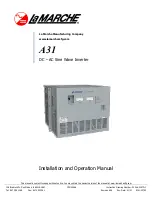
FS2 v2.1r1
www.aja.com
101
Chapter 6: SNMP
FS2 Simple Network Management Protocol
SNMP is defined as a “simple network management protocol” and was specified as a
component of the internet protocol suite by the Internet Engineering Task Force (IETF).
The FS2 can act as a
network element
that issues SNMP trap messages signaling a
detected alarm condition or other system condition. A device’s trap messages are
defined in an MIB (Management Information Base) file. The trap messages are sent to a
server-based external NMS destination. For example, the FS2 could send a trap message
if one of its redundant power supplies becomes unplugged. A client software agent that
communicates with the NMS might then get a message telling the operator what has
happened.
The FS2 must be configured for SNMP messaging. By default SNMP is disabled on the
FS2. Besides activating SNMP, trap destinations must also be defined with fixed IP
addresses.
When SNMP is enabled, one or more of these alarms may be sent by the FS2 to the client
network management system (NMS) as a trap message:
• fs2PowerSupplyAlarm (PS1 Alarm)
• fs2 PowerSupply2Alarm (PS2 Alarm)
• fs2ReferenceAlarm (Ref Video Alarm)
• fs2Vid1ReferenceAlarm (Vid1 Ref Video Alarm)
• fs2Vid2ReferenceAlarm (Vid2 Ref Video Alarm)
• fs2Vid1FormatAlarm (Vid1 Format Alarm)
• fs2Vid1BackgroundAlarm (Vid1 Background Format Alarm)
• fs2Vid2FormatAlarm (Vid2 Format Alarm)
• fs2Vid2BackgroundAlarm (Vid2 Background Format Alarm)
• fs2OverTemperatureAlarm (FS2 Over Temperature Alarm)
SNMP Configuration
FS2 SNMP configuration can be accomplished using the front panel or with the web
browser computer interface (if Remote Control is enabled).
Front Panel Screens
The FS2 front panel screens for SNMP are accessible through the CONFIG button. The
direct SNMP configuration screens are:
• 4.0 SNMP Enable
• 4.1 SNMP Trap Destination 1
• 4.2 SNMP Trap Port 1
• 4.3 SNMP Trap Destination 2
• 4.4 SNMP Trap Port 2
These SNMP direct configuration parameters are described later in this chapter.
USO
RESTRITO
















































